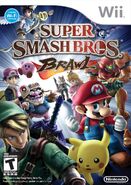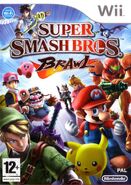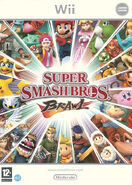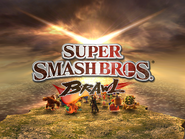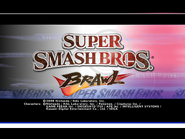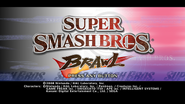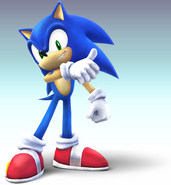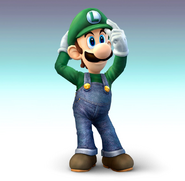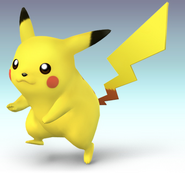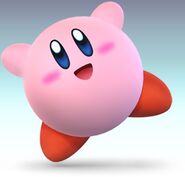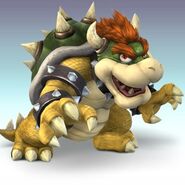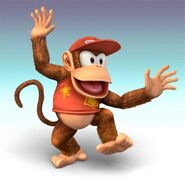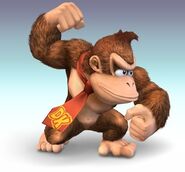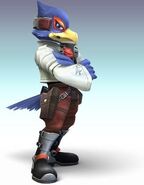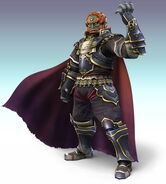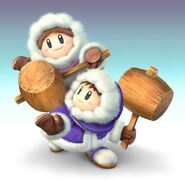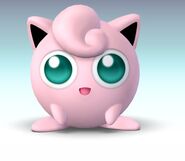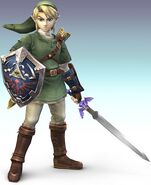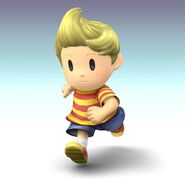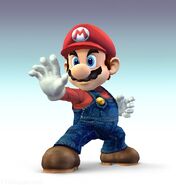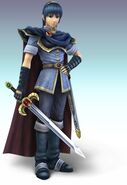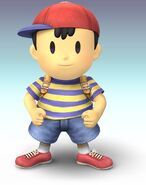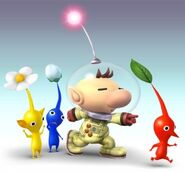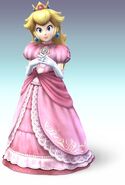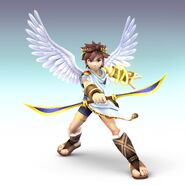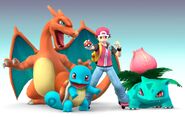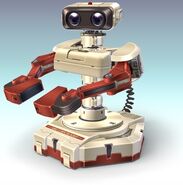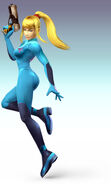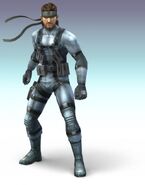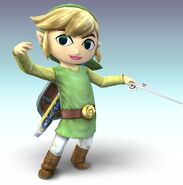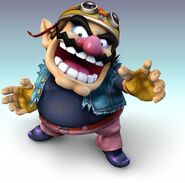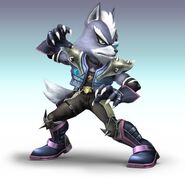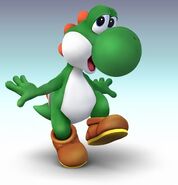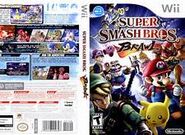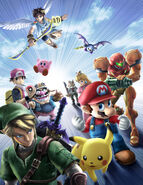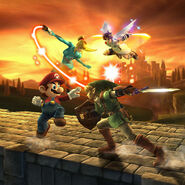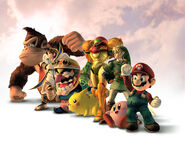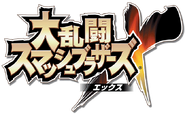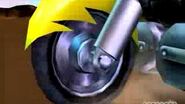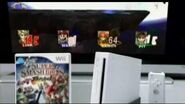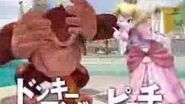Super Smash Bros. Brawl (大乱闘スマッシュブラザーズX, Great Fray Smash Brothers X), often shortened to "SSBB" or "Brawl" (スマブラX), is the third installment in the Super Smash Bros. series published by Nintendo. The game was directed by Masahiro Sakurai, who also created the two preceding Super Smash Bros. games, and was developed by an ad hoc development team consisting of Sora, Game Arts, and staff from other developers. The game released for the Wii on January 31st, 2008 in Japan, March 9th, 2008 in North America, June 26th, 2008 in Australia, and June 27th, 2008 in Europe. The game requires 128 free blocks of memory in the Wii System Memory. A limited edition release of the game came with an extra cardboard sleeve depicting all of the characters available by default, and came with two postcards, providing a biopic on Zero Suit Samus and Zelda, giving a short summary of them, and showing images of their special moves.
Brawl is fundamentally similar to its predecessors Super Smash Bros. and Super Smash Bros. Melee, being a fighting game that contains characters with simple movesets and an emphasis on movement and ringouts. However, Brawl introduced many elements that would become standard in later installments, such as an expanded adventure mode and support for online play through the Nintendo Wi-Fi Connection. No data, except some vault data, can be copied to an SD Card or transferred onto another Wii. If the player does not create a save file when they start, they were unable to play via Nintendo Wi-Fi Connection and vault data will not be saved. However, as of May 20, 2014, the Nintendo Wi-Fi Connection has been shut down therefore making it impossible for anyone to play Brawl online without hacking. While some characters were cut from Melee, many more were introduced, including third-party characters for the first time in the series.
Most of the game's musical score is made up of newly-arranged versions of pieces that originated in earlier video games starring the characters featured in Brawl, with the remainder taken directly from the original games. The new arrangements were composed in a collaboration between 38 renowned video game composers and has been critically acclaimed for its representation of different generations in gaming history.
Brawl received universal acclaim, with praise centered on its entertainment value despite issues relating to its content loading times, and its musical score was lauded for its representation of different generations in gaming history. The game has sold 13.32 million units as of March 31, 2020, making it the eighth best-selling Wii game of all time.
Intro[]
Characters[]
- Main article: Character
The cast of characters includes various returning characters from Melee as well as a variety of newcomers to the game. Unfortunately, Roy, Dr. Mario, Young Link, Pichu, and Mewtwo were cut. Some returning characters have been updated or refined since their last appearance - in terms of appearance, fighting capabilities, or both. For example, Link and Fox McCloud have taken on new designs from more recent titles, while Samus Aran has gained the ability to change into Zero Suit Samus by using her Final Smash.
Some previously represented series have had one or more of their other characters added to Brawl. Diddy Kong (from the Donkey Kong series) and Ike (from the Fire Emblem series) make their first appearance in the Smash Bros. series, preceded by Donkey Kong and Marth, respectively.
Other newcomers are the first to represent their series: characters like Pit, representing the Kid Icarus series, which has not been seen in a video game since the 1991 Game Boy game Kid Icarus: Of Myths and Monsters, Wario, an occasional antagonist of Mario's from Nintendo's highly successful WarioWare and Wario Land series, and Captain Olimar from the Pikmin series. Solid Snake, the main protagonist of the Metal Gear franchise, and Sonic the Hedgehog from his eponymous series become the first third-party characters to appear in a Super Smash Bros. game.
Playable characters[]
Bold: Donates unlockable
Veterans[]
| Image | Name | Series | Debut |
|---|---|---|---|

|
Mario | Mario | Donkey Kong (1981) |

|
Luigi | Mario | Mario Bros. (1983) |

|
Peach | Mario | Super Mario Bros. (1985) |

|
Bowser | Mario | Super Mario Bros. (1985) |

|
Donkey Kong | Donkey Kong | Donkey Kong (1981) |

|
Yoshi | Yoshi | Super Mario World (1990) |

|
Link | The Legend of Zelda | The Legend of Zelda (1986) |

|
Zelda | The Legend of Zelda | The Legend of Zelda (1986) |

|
Sheik | The Legend of Zelda | The Legend of Zelda: Ocarina of Time (1998) |

|
Ganondorf | The Legend of Zelda | The Legend of Zelda: Ocarina of Time (1998) |

|
Samus | Metroid | Metroid (1986) |

|
Ice Climbers | Ice Climber | Ice Climber (1985) |

|
Kirby | Kirby | Kirby's Dream Land (1992) |

|
Fox | Star Fox | Star Fox (1993) |

|
Falco | Star Fox | Star Fox (1993) |

|
Captain Falcon | F-Zero | F-Zero (1990) |

|
Pikachu | Pokémon | Pokémon Red/Green (1996) |

|
Jigglypuff | Pokémon | Pokémon Red/Green (1996) |

|
Marth | Fire Emblem | Fire Emblem: Shadow Dragon and the Blade of Light (1990) |

|
Ness | Earthbound/Mother | EarthBound (1994) |

|
Mr. Game & Watch | Game & Watch | Ball (1980) |
Newcomers[]
| Image | Name | Series | Debut |
|---|---|---|---|

|
Diddy Kong | Donkey Kong | Donkey Kong Country (1994) |

|
Wario | Wario | Super Mario Land 2: 6 Golden Coins (1992) |

|
Toon Link | The Legend of Zelda | The Legend of Zelda: The Wind Waker (2002) |

|
Zero Suit Samus | Metroid | Metroid: Zero Mission (2004) |

|
Pit | Kid Icarus | Kid Icarus (1986) |

|
R.O.B. | R.O.B. | Stack-Up (1985) |

|
Meta Knight | Kirby | Kirby's Adventure (1993) |

|
King Dedede | Kirby | Kirby's Dream Land (1992) |

|
Olimar | Pikmin | Pikmin (2001) |

|
Wolf | Star Fox | Star Fox 64 (1997) |

|
Pokémon Trainer | Pokémon | Pokémon Red/Green (1996) |

|
Lucario | Pokémon | Pokémon Diamond/Pearl (2006) |

|
Ike | Fire Emblem | Fire Emblem: Path of Radiance (2005) |

|
Lucas | Earthbound/Mother | Mother 3 (2006) |

|
Snake | Metal Gear | Metal Gear (1987) |

|
Sonic | Sonic the Hedgehog | Sonic the Hedgehog (1991) |
Unplayable characters[]
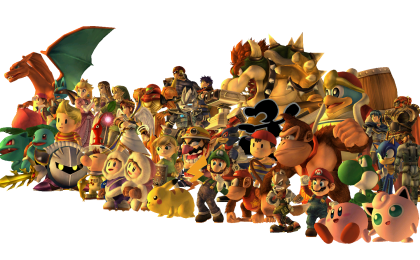
Complete cast of characters excluding Zero Suit Samus and Sheik.
Bosses[]
Master Hand
Crazy Hand
Petey Piranha
Rayquaza
Galleom
Duon
Ridley
Meta Ridley
Porky Minch
Porky Statue
Tabuu
Stages[]
There are 41 stages in the game, 31 stages which are new to the game and 10 stages returning from the last game Super Smash Bros. Melee.
Bold denotes unlockable stages.
Items[]
Bold donates new item.
Collectibles[]
Returning from Melee are trophies, statuettes of Nintendo characters and objects that can be collected in the game. These trophies give a brief history of the object it shows. In addition to trophies, players will now be able to collect stickers of Nintendo artwork. Players will be able to place stickers and trophies onto virtual backgrounds and record snapshots, which can be sent to other players via Nintendo Wi-Fi Connection. Another new item appearing in the game is CDs, which, when obtained, offers new music choices for playable stages. By completing stages in the Classic Mode, coins can be earned. The coins can be used to play the Coin Launcher to get stickers or trophies.
Development[]
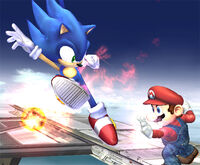
Sonic fighting Mario on the Lylat Cruise stage.
At the pre-E3 2005 press conference, the president of Nintendo, Satoru Iwata, announced the next installment of Super Smash Bros. was not only already in development for their next gaming console, but would be a launch title with Wi-Fi compatibility for online play. The announcement was unexpected to the creator of the Super Smash Bros. series, Masahiro Sakurai. Back in 2003, he had left HAL Laboratory, the company that was in charge with the franchises' and the Kirby series' development and was never informed of this announcement despite the fact shortly after resigning from the company, Iwata said if a new game was to be made, he would be in charge. It was not until after the conference Sakurai was called to Satoru Iwata's room on the top floor of a Los Angeles hotel where he was told by Iwata, "We'd like you to be involved in the production of the new Smash Bros., if possible near the level of director". Although originally announced to be a launch title, Sakurai stated "I decided to become director. And as of May, 2005, I was the only member of the new Smash Bros. development team". Development of the game never actually started until late 2005, and just for its production, Nintendo opened a new office in Tokyo at the beginning of October 2005. Nintendo also enlisted outside help from a company who, at that point in time, just finished development of a major title. Sakurai also stated that these people had spent excessive amounts of time playing Melee. This team will have access to all the original material and tools from the development of Melee, courtesy of HAL Laboratory. Also, several Smash Bros. staff members that reside around the area of the new office have joined up on the project's development.
At the Nintendo Media Conference at E3 2007, it was announced by Nintendo of America president Reggie Fils-Aime that Brawl would be released on December 3rd, 2007 in the Americas. However, just two months before its anticipated December release, the development team asked for more time to work on the game. During the Nintendo Conference on October 10th, 2007, Nintendo of Japan president Iwata announced the delay, saying:
| “ | In order to fine tune Smash Bros., with this unprecedented game depth, we have decided that we have to take a little more time to complete the game than we announced before. We are sorry for the fans that are already anxiously waiting for the launch, but we would like to launch this game on January 24th, 2008 in Japan. As for the North American launch, we will review that too, and our local subsidiaries will make their own announcements. | ” |
On October 11th, 2007, George Harrison of Nintendo of America announced that Brawl would be released on February 10th, 2008 in North America, but was later delayed to March 9th, 2008.
Inclusion of characters[]
Sakurai stated in multiple interviews that some characters who made their debut as fighters in Brawl were initially considered to be included in Super Smash Bros. Melee. For example, Hideo Kojima suggested the idea of including Solid Snake in Melee to Sakurai, which did not happen because development was too far in for Melee at the time. This would lead to Snake ultimately being included in Brawl instead. Additionally, Lucas was supposed to be used in Melee, but was excluded due to the constant delay and ultimate cancellation of Mother 3 on the Nintendo 64.
Music[]
- See also: My Music, Music (SSBB), Super Smash Bros. Brawl Main Theme
On May 22nd, 2007, Sakurai revealed a list of thirty-six composers providing music for the game. Sakurai stated that he had asked the composers, who come from a variety of companies and have written music for first-, second-, and third-party games, "to listen to an elite selection of Nintendo music and arrange several of their favorite songs." The game's various stages have multiple musical tracks which players can listen to using the new "My Music" feature, including some songs that were taken directly from other games without any modification or special arrangement. This feature also allows the player to adjust the frequency of how often a song gets played during a stage. It is possible to unlock more songs on this feature by collecting CDs during gameplay.
Masterpieces[]
- Main article: Masterpieces
Masterpieces are a new feature to the Super Smash Bros. series. They are Virtual Console demo versions of several older Nintendo games, each one featuring at least one of the characters playable in Brawl. Some of them must be unlocked, and all of them have time maximums. Interestingly, the Japanese release has two more masterpieces than the international releases. These two masterpieces are EarthBound and Fire Emblem: Monsho no Nazo.
Trailers[]
Several different trailers for Brawl were released before the game came out. The original trailer was shown at E3 2006 on May 11th, 2006 and revealed Solid Snake as a playable character. A second trailer was shown at the Nintendo World 2006 convention in December, and revealed Fox's return as a playable character. A third trailer was shown as the October 10th, 2007 Nintendo Press Conference, which revealed Sonic as a playable character. A final trailer showcasing Brawl's adventure mode, the Subspace Emissary, was released on Friday, December 21st, 2007. This trailer revealed that Ike and the Ice Climbers would appear in this mode, among other things.
All the trailers can be found in the game as data for the player to watch.
Changes from Melee to Brawl[]
Gameplay Changes:[]
- All returning veterans have a slower falling speed and gravity
- L-cancelling has been removed
- Air dodging has been reworked so the character continues on the path taken before the air dodge rather than shifting direction, removing the use of wavedashing
- Hitstun has been severely reduced, limiting the use of true combos
- Characters can survive longer due to being able to act before knockback wears off
- Spikes no longer exist
- Meteor Smashes are easier to land due to the increased trajectory angle and additional moves that send opponents downward
- Meteor cancelling frames are different for all characters
- Shieldstun has been decreased
- The chances of having a perfect shield are increased
- Characters can grab the ledge while having their back toward it
- Ledge recovery is easier due to most recovery moves cancelling so the character can grab the ledge
- Forward tilts and smash attacks are easier to angle
- Smash attacks have increased power
- Up smashes can be performed while dashing, also known as a slide smash
- Footstool jumping allows characters to jump on the opponent's head and send them tumbling downward
- Tether recoveries allows characters with extended grabs (or some attacks), to automatically grab the ledge when executed.
- Crawling allows certain characters to dodge attacks while on the ground, though usefulness depends on the character
- Gliding allows characters with wings to use them to fly in any given direction, increasing their recovery options
- Wall clinging allows characters to cling to walls, which can be followed by a jump
- Swimming is introduced allowing characters to survive in water as opposed to just falling through it
- Short hopping is easier to perform
- A tripping mechanic has been implemented which can be used in disrupting attacks
- Random tripping can occur when mashing the control stick
- Items can now be grabbed during dash attacks, aerial attacks, and aerial dodges
- Projectile items can now be used while moving or jumping, as opposed to standing still
- The speed and damage of pummeling depends on the character; heavy characters are slow but inflict more damage, while small and fast characters inflict less damage at a faster pace
- Pivot grabbing is available for all characters
- Teching is more difficult to perform due to the ability to air dodge while tumbling
- The CPU behavior has been improved
- Final Smashes for all characters have been implemented due to the addition of the Smash Ball
Aesthetic Changes[]
- All veterans have received more realistic and detailed textures based off of their current game
- Most characters have new voice acting that better resembles their current appearance in games
- While fighters such as Donkey Kong, Diddy Kong, and Bowser have received more realistic animal noises, Yoshi in particular has maintained his cartoony voice
- Sound effects are balanced between the two previous games: while they are slightly more subdued than Smash 64, they are much more pronounced than in Melee.
- Clones in Melee have new animations or properties to attacks that differentiate the two (Falco and Fox, Ganondorf and Captain Falcon)
- All of the characters' universe symbols have more detailing (Metroid, Star Fox), while others have been completely replaced with recent ones (Mario, Yoshi)
- All characters have three taunts, as opposed to one(or in Pichu’s case, two)
- On-screen appearances return from Smash 64, though the original 12 has enhanced graphics while Melee and Brawl newcomers have unique ones
- The visual appearance of some moves such as Fireball and Falcon Punch are more realistic
- Some of the visual effects of moves has been reworked to better suit the character's appearance, such as Peach Bomber releasing hearts as opposed to fire in Melee
- Returning attack effects are more realistic and brighter
- The damage meter now shows a smaller portrait of the character as well as their name to better differentiate between players
- The character universe symbol is smaller and placed at the right side of the damage meter
- The damage meter will become opaque when a character stands behind it
- The damage meter will display parts of the Dragoon that the player has collected to the side
- The damage percentage will go from white, pink, red, and maroon to indicate the damage inflicted
- The damage percentage will explode when the character is KO'd
- Smash taunts only end when the character initiating it has been KO'd as opposed to just flinching
- Shrinking and growing animations for each character has been added
- Yells heard when hit by knockback-inducing attacks depends on how long the character is in stun
- Characters now make two sounds when KO'd
- The number of sounds when initiating aerial attacks and tilts has increased
- One sound is made when using a smash attack
- Most items have received a visual update to better resemble their current appearance, such as the Fire Flower
- The Home-Run Bat has a new wind-up animation, making the attack slower
General Changes[]
- Super Smash Bros Brawl can be played with the Wii Remote and Nunchuck, Wii Remote held sideways, Classic Controller, or GameCube Controller
- The number of characters for names has increased to five
- Players can now customize their controls saved to their names
- Classic Mode now involves the player fighting in events against characters from the same universe, along with allies from the same universe
- All-Star Mode has been reworked so that the player fights all the characters from their certain universe at their home stage, and progresses from the oldest universe to the newest one
- Adventure Mode in Melee has been succeeded by a story mode The Subspace Emissary
- The inclusion of the Subspace Emissary offers an additional way of unlocking characters
- Target Test, renamed Target Smash!!, uses five stages for all characters as opposed to personalized stages
- Boss Battle Mode has been introduced, allowing players to fight bosses from the Subspace Emissary.
- Special Brawl's effects can be combined
- Events now have three difficulty levels
- Events, Home-Run Contest, All-Star Mode, Adventure Mode, and Target Smash can be played by two players
- The Sound Test is available from the start
- Stickers can be collected which can be used in Adventure Mode
- Custom stages can be built
- Players can save screenshots of battles without having to play Camera Mode
- Players can record any brawls fought and replay them
- Players can fight online by using Nintendo WFC (no longer available by normal means)
Voice actors[]
- Eric Newsome - Bowser, Meta Knight
- Ryō Horikawa - Captain Falcon
- Shin'ichirō Miki - Charizard
- Dex Manley - Falco
- Jim Walker - Fox
- Hironori Miyata - Ganondorf
- Sanae Kobayashi - Ice Climbers
- Jason Adkins - Ike
- Craig Blair - Ivysaur
- Rachael Lillis - Jigglypuff
- Masahiro Sakurai - King Dedede
- Makiko Ōmoto - Kirby, Ness, Lyn (Japanese)
- Akira Susanuma - Link
- Bill Rogers - Lucario
- Lani Minella - Lucas, Pit, Lyn (English)
- Charles Martinet - Mario, Luigi, Wario, Waluigi
- Hikaru Midorikawa - Marth
- Jay Ward - Wolf
- Samantha Kelly - Peach
- Ikue Ōtani - Pikachu
- Michele Knotz - Pokémon Trainer, Squirtle
- David Hayter - Solid Snake
- Jason Griffith - Sonic
- Sachi Matsumoto - Toon Link
- Kazumi Totaka - Yoshi
- Jun Mizusawa - Zelda, Sheik
- Alésia Glidewell - Zero Suit Samus
- Pat Cashman - Narrator, Master Hand, Crazy Hand
Codec:
- Paul Eiding - Roy Campbell
- Christopher Randolph - Otacon
- Kim Mai Guest - Mei Ling
- Jim Walker - Leon Powalski
- Dex Manley - Peppy Hare, Panther Caruso
- Alésia Glidewell - Krystal
- Michael McAuliffe - Slippy Toad
Note: Mr. Game & Watch, Olimar, R.O.B and Samus have no voices, therefore, no voice actors. It was rumored that voice actor Jim Cummings voiced Bowser in this game, but this rumor was later proved false. DK and Diddy Kong haves realistic animal-like sounds in this game, Instead to their cartoonish voices, Takashi Nagasako and Katsumi Suzuki. DK was gave realistic gorilla roars and Diddy Kong is screeching like a real monkey.
Gallery[]
Trailers and Commercials[]
Trivia[]
- To the dismay of many NTSC owners of Brawl, the game does not come with Japanese audio or text options as Melee did.
- Brawl is the first game where the announcer does not yell the game's title at the title screen.
- It is also the only game where the player does not have to process through the title screen when starting the game.
- The opening does not show hidden characters (such as Toon Link, Wolf, etc.) until unlocked, like in the first Super Smash Bros., with the exception of Ness, Marth, Sonic and Snake.
- Some non-human characters (like Donkey Kong and Diddy Kong) use more realistic sounds rather than their usual cartoonish sounds in their own games. Yoshi, in particular, keeps his cartoonish voice.
- The Brawl menu was designed almost identically to Kirby Air Ride, along with the Challenges Checklist.
- Super Smash Bros. Brawl is first installment in the Super Smash Bros. series:
- to introduce items that are worn as badges.
- to introduce a playable character who was created outside Japan (Diddy Kong).
- to introduce playable characters who did not make their first appearance in a video game (Lucario and R.O.B.).
- to have some characters not return (as Roy, Dr. Mario, Young Link, Pichu, and Mewtwo do not return).
- Roy was replaced by Ike, Young Link was replaced by Toon Link, and Mewtwo was replaced by Lucario.
- In this game, Falco --clone of Fox-- and Ganondorf --clone of Captain Falcon-- are the only two clones (from Super Smash Bros. Melee) that returned as playable characters.
- where all the Mario Party series characters from the "Original 6" --Mario, Luigi, Yoshi, Donkey Kong, Peach, and Wario-- are playable characters (discounting the Brawl newcomer Diddy Kong).
- That is, now that Peach and Wario are playable characters (beginning with this installment).
- In fact, these two characters Peach and Wario have been playable characters in all the games of the Super Smash Bros. series from Super Smash Bros. Melee, Super Smash Bros. Brawl, and onward.
- And now, since Brawl, all the Mario Party series characters from the "Original 6" are playable in the Super Smash Bros. series games.
- In fact, these two characters Peach and Wario have been playable characters in all the games of the Super Smash Bros. series from Super Smash Bros. Melee, Super Smash Bros. Brawl, and onward.
- The newcomer Peach was introduced in Melee, while the newcomer Wario was introduced here in this game (that being, Brawl). The remaining four characters (Mario, Luigi, Yoshi, and Donkey Kong) started with the original Super Smash Bros.. So all the characters from the "Original 6" --in the Mario Party series-- are playable characters in the Super Smash Bros. series games (beginning with Brawl). That is, Mario, Luigi, Yoshi, Donkey Kong, Peach, and Wario.
- While Bowser began the Smash series with Melee and returned in all later installments --beginning with Brawl-- he remained as a non-playable character --in the Mario Party series games-- until the two later Mario Party series games (that is, Super Mario Party and Super Mario Party Jamboree). (That is, if counting just the home console games in the Mario Party series.)
- For the other playable protagonists of the Mario Party series games, while Diddy Kong's first playable appearance was Brawl, Rosalina's first playable appearance in the series was Smash 4 and Daisy's was Smash Ultimate. Waluigi has only appeared as an Assist Trophy character since Brawl, Smash 4, and Smash Ultimate. Birdo has appeared as a stage hazard on the Mushroom Kingdom II stage in both Melee and Ultimate. Pauline has appeared as a sticker in Brawl, a trophy in Smash 4, and a spirit in Ultimate. For the remaining two characters --Toad and Toadette-- Toad has appeared as Peach's neutral special move and as a trophy and sticker (in Brawl and Smash 4) and a spirit (in Ultimate) while Toadette appears as a trophy and/or sticker (in Brawl and Smash 4) and a spirit (in Ultimate).
- Bowser Jr. (the successor to Koopa Kid in later Mario Party series games) is the only host to be playable in the Super Smash Bros. series. (That is, starting with Smash 4 and Ultimate.)
- Prior to Smash 4 and Ultimate, he (Bowser Jr.) only appeared as a collectible trophy in Brawl.
- That is, now that Peach and Wario are playable characters (beginning with this installment).
- While the Wii Remote speaker is generally unused, there are two instances where it is used:
- When a player selects a character, the character will make a noise through the speaker, but only some remotes will do this.
- After minigames on Wario Ware, Inc., a different sound effect will be heard depending on how the player did.
- Brawl is the only game where stocks are measured by dots instead of avatars of the character's face.
- It is also the only game where the stock icons go down from left to right rather than the other way around.
- Kid Icarus: Uprising seems to have picked up some things from Brawl, such as a Boss Battle mode, a dash mechanic, a checklist for challenges, etc.
- Super Smash Bros. Brawl is even referenced out loud by Palutena and Pit, Palutena referring to it as Super Bash Sisters out of forgetfulness.
- Brawl is the only game in the Super Smash Bros. series to support both fullscreen and widescreen (without hacking in any way).
- Ever since the first Super Smash Bros., Sakurai wanted to include Final Smashes. Sakurai finally found the proper software to make it happen in Super Smash Bros. Brawl.
- Super Smash Bros. Brawl is the slowest game in the series. Sakurai did this because he found Super Smash Bros. Melee too fast for beginners.
- Along with the random tripping mechanic, as a result, competitive players and people who enjoyed the faster-paced gameplay of Melee view Brawl as the ‘black sheep‘ of the series.
- Brawl and Ultimate are the only games to introduce new characters that use a tether recovery as their up special move.
- Brawl is the only game:
- to not introduce new characters who are clones.
- where unlockable characters can be unlocked without battling them first (via joining them in The Subspace Emissary).
- However, to unlock the last three unlockable characters (Toon Link, Wolf, and Jigglypuff), the player is forced to defeat them in a one-on-one match to have them join their party. (That is, if the player uses the S.S.E method to unlock them.) That is by revisiting the stages The Forest, The Ruins, and The Swamp (to unlock them).
- to not feature Dream Land 64 as a playable stage.
- It is also the only installment where none of the stages from the original Super Smash Bros. return as retro stages. In fact, this is the only installment to not have any content return from the original game.
- However, there are two exceptions. The first exception of the two is Credits (Super Smash Bros.). This song returns in the form of its music track from the original game and plays as one of the songs on the stage Final Destination. The other exception is mentioned on event descriptions in the two respective solo events Event 10: All-Star Battle Regulars and Event 29: All Star Semifinal Regulars. In Event 10: All-Star Battle Regulars, the player must defeat all of the characters from Smash 64's Original 8 (Link, Yoshi, Fox, Mario, Pikachu, Donkey Kong, Kirby, and Samus). In Event 29: All Star Semifinal Regulars, the player must defeat the four other characters from the Original 12 (Ness, Captain Falcon, Luigi, and Jigglypuff).
- It is also the only installment where none of the stages from the original Super Smash Bros. return as retro stages. In fact, this is the only installment to not have any content return from the original game.
- to not include a newcomer from the Super Mario Bros. universe as a playable character.
- This does not include Mario sub universes such as the Yoshi's Island, Donkey Kong, and Wario Ware universes. The Donkey Kong and Wario Ware universes introduce two Mario sub universe newcomers as playable characters. That is, Diddy Kong and Wario respectively. But if only counting the Super Mario Bros. universe, there are no newcomers from the said universe introduced in this installment.
- Brawl is the last game to include a new fighter from The Legend of Zelda universe.
- Brawl's character roster (and Character Selection Screen) has characters of the same franchise be in the same category.
- Additionally, all the characters from the Original 8 (except Yoshi) are all aligned and organized on the top row.
- None of the characters on the horizontal rows is from a specific order, as all the characters from matching universes are organized vertically. The one exception is the top row. (That is, where all of the characters from the "Original 8" --except Yoshi-- are in the same category.)
- A similar method happens with Super Smash Bros for 3DS/Wii U where characters from the same franchise are one the same row as each other(the a few exceptions, namely Dr. Mario, Dark Pit, Lucina, Mewtwo, Lucas and Roy, the latter of whom being DLC characters).
- Additionally, all the characters from the Original 8 (except Yoshi) are all aligned and organized on the top row.
- This is the only post Smash 64 game where Mewtwo does not appear.
- It’s also the first Super Smash Bros game where Fox’s eyes are green, just like in his home series, unlike the first two Super Smash Bros games, where his eyes are blue instead. It’s also the first one where Fox and Falco don’t have the same eye colour, the second one being the next Smash game, since Falco still have blue eyes.
- Out of all the Smash titles he appears in, Brawl is the only game where Falco isn’t the character with the highest jump.
External links[]
- Official Super Smash Bros. Brawl website
- Wikipedia's Super Smash Bros. Brawl article
- SmashWiki Article
| |||||





































































































